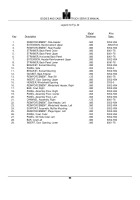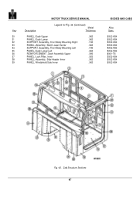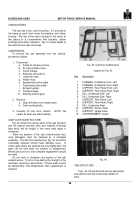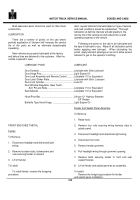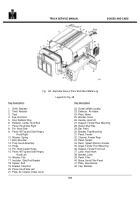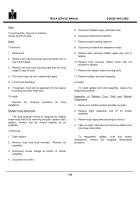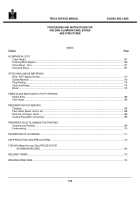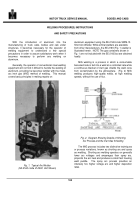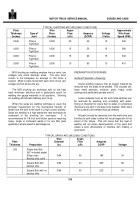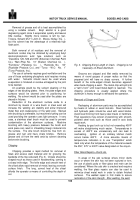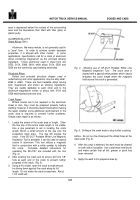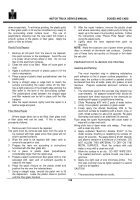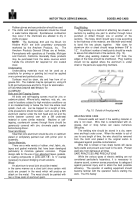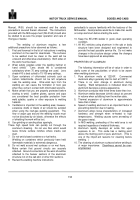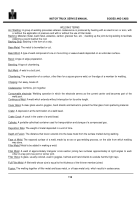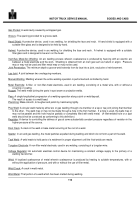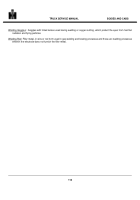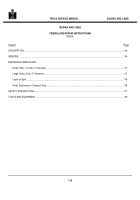TM-5-3805-254-14-P-2 - Page 108 of 894
MOTOR TRUCK SERVICE MANUAL
BODIES AND CABS
Removal of grease and oil is best accomplished by
using a suitable solvent.
Butyl alcohol is a good
degreasing agent since it evaporates quickly and leaves
little residue.
Slightly more residue is left by “per-
Trolene, Solvent M-2”1 (John D.
Moore, Nutley, N.J.
),
but this solvent has the advantage of a relatively high
flash point.
Both removal of oil residues and the removal of
aluminum oxides may be obtained by employing butyl
alcohol-phosphoric
acid
type
solutions
such
as
“Deoxidine 126, 526 and 670 (American Chemical Paint
Co.), “Met-l-Prep No.
10” (Nielson Chemical Co.
),
“Ferrotone” (Penetone Co.
), “Rusticide No.
50”
(Rusticide Products Co.), and “’Turco - W.O.
No.
1”
(Turco Products, Inc.).
The use of solvents requires good ventilation and the
use of those containing phosphoric acid requires rinsing
with water.
Solvents should never be used where
evaporation is hindered or residue entrapped by the joint
to be welded.
An example would be the solvent cleaning of the
edges of two abutting plates.
Here, the plate edges and
surfaces would be cleaned prior to positioning for
welding.
No solvent would be used after the plates are
placed in fixtures.
Reduction of the aluminum surface oxide to a
minimum by means of a wire brush or steel wool will
increase the welding arc stability and allow improved
metal flow and coalescence of the weld pool.
Manual
wire brushing is preferable, but machine brushing can be
used providing the operator uses light pressure.
In any
case, a stainless steel brush must be used to prevent
contamination of the aluminum surfaces.
Machine
brushing with heavy pressure between the brush and
work piece can result in imbedding foreign material into
the surface.
The wire brush should be free from oil,
grease and rust and have sharp bristles.
Remove
grease and oil from the weld area by solvent cleaning
before wire brushing.
Chipping
Chipping provides a rapid method for removal of
flaws and excess weld material and for grooving the
backside of the two-side weld (Fig. 3).
Chisels should be
shaped much as those used in woodworking, coming to
a sharp knife edge.
The knife edge and smooth heel of
the chisel allow rapid removal of metal, leaving a smooth
surface finish.
The long, curved heel of the chisel
affords the operator a means of controlling the depth of
cut.
Fig. 3.
Chipping Along Length of Crack.
Chipping is not
necessary on Sheet Aluminum.
Grooves are chipped and fillet welds removed by
means of round gouges of proper radius so that the
prepared joint will have no sharp corners.
A further
benefit of the knife-edged chisels becomes apparent
when back-chipping a weld.
The metal chip will split into
a “ram’s horn” until fused metal depth is reached.
The
chipping procedure is usually applied where the
aluminum is heavy enough to withstand the operation.
Removal of Dinges and Dents
Reshaping of aluminum parts may be accomplished
by means of rubber or wood mal-lets.
Steel hammers
and hydraulic jacks should be used with wood blocks.
Avoid local thinning from heavy steel mauls or hammers.
Final operations may consist of planishing with smooth,
polished steel tools such as those used in auto body
repair work.
Heating by gas torch up to but not exceeding 400°F
will make straightening much easier.
Temperatures in
excess of 400°F are unnecessary and can lead to
overheating.
Ignition of, an ordinary kitchen match
occurs below 400
°
F.
A more accurate means of
tempera-ture indication is to use “Tempilstiks” which
mark only when the temperature of the material exceeds
the 350
°
, 375
°
or 400°F value designated on the crayon.
Fiber Glass Repairs—Dents etc.
In areas of the cab surfaces where minor dents
occur or where the skin has not been ruptured or torn,
the use of plastic putty or fiber glass and resin can be
considered. Where the cab skin is cracked and requires
welding, the fiber glass repairs can also be used to
minimize sheet metal work in order to obtain finished
surfaces.
The welded repair is first made to assure
restoration of the skin strength.
After welding, the weld
106
Back to Top

